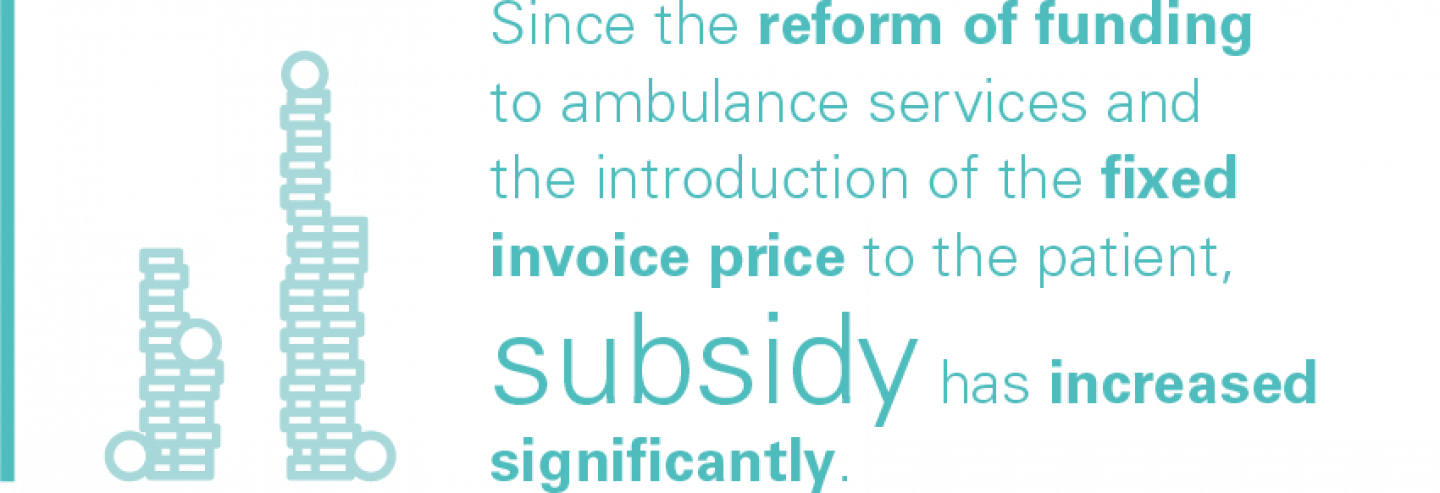In 2018, the way ambulance service grants are allocated was reformed.[1] Prior to 2018, ambulance services received a flat fee for each duty shift they operated. However, since the reform, the allowance for an ambulance service consists of 2 (or 3) parts:
- Activation premium: allowance for the journeys made. This is calculated on the basis of the number of journeys made and total number of kilometres travelled in the past year.
- On-call bonus: allowance for operating their on-call rotation(s). The ambulance services are remunerated on the basis of a points system, depending on the number of duty shifts they operate, their opening hours (day, night, Sundays and public holidays, etc.), accommodated or unaccommodated duty shift.
- Possible compensation premium: a compensation premium was provided for the period 2019-2020-2021. For any ambulance service that receives a lower average subsidy per journey in the years 2019-2020-2021 compared to 2017, that difference will be adjusted to the 2017 level. In 2021, this kind of compensation premium was paid out for the last time.
The above relates to the funding of regular ambulance services and PIT functions.
FUNDING FOR AMBULANCE SERVICES
Since the reform, subsidies for ambulance services have been significantly increased. This is the result of the introduction of a fixed invoice price, which ambulance services can charge to the patient[2]. This fixed invoice price was in many cases lower than what the ambulance services previously charged their patients. To compensate for this loss of resources through the patient, the allowance from the government was substantially increased. Moreover, in 2020, an extra one-off grant of 8 million euros was provided for the ambulance services because of the COVID-19 pandemic.

The Medical Emergency Group (MUG/SMUR) function is funded on the one hand via the Financial Resources Budget (FRB)[3] for hospital funding. The MUG/SMUR function is financed on a flat-rate basis here, with a single amount being granted for each accreditation. This means that no account is taken of the real cost and that no contribution for the MUG/SMUR can be charged to the patient. On 1/1/2021, this flat-rate funding amounted to 318,100.20 euros per recognised MUG/SMUR function. For Belgium, this means a total amount of more than 26 million euros[4]. On the other hand, the MUG/SMUR function is funded through the charging of specific fee codes to the patient and the health insurance. In this context, the National Institute for Health and Disability Insurance (NIHDI) paid out an amount of over 8 million euros in 2020.[5]
[1]The legal basis for this reform is the funding RD of 6 December 2018 – Royal Decree establishing the terms and conditions for granting the allowance referred to in Article 3ter of the Act of 8 July 1964 on emergency medical assistance.
[2]This was laid down in the Royal Decree of 28 November 2018 on invoicing following the provision of emergency medical assistance by an ambulance service
[3]See Key Data for General Hospitals for more information on the Financial Resources Budget.
[4]The funding for the MUG/SMUR function is described in the Royal Decree of 25 April 2002 on the establishment and settlement of the financial resources budget for hospitals in article 68.
[5]Source: Medical Care Service, Directorate of Research, Development and Quality Promotion, NIHDI
